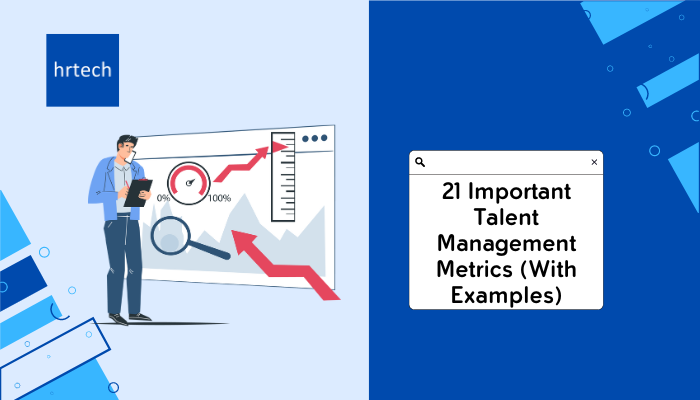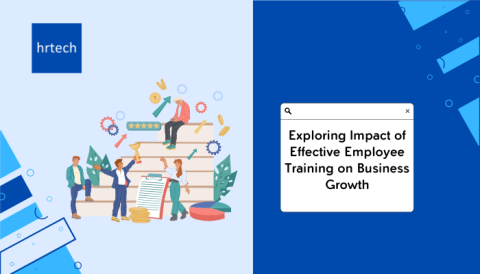Are you measuring the right talent management metrics?
In this guide, we’ll share the top 21 talent management metrics, with examples to help you get started. Keep reading till the end to explore more.
Transforming HR through Agile Workforce Solutions
Talent Management Metrics: A Quick Overview

What Is Talent?
Talent refers to the skills, knowledge, and abilities of your workforce. It’s the unique combination of traits each employee brings to their role. Some examples of talent include:
A software engineer’s coding expertise
A salesperson’s relationship-building skills
A manager’s ability to motivate and develop their team
Talent is your company’s most valuable asset. It’s what drives innovation, productivity, and ultimately, business success.
What Are Talent Management Metrics?
Talent management metrics are specific measures used to track the effectiveness of your talent strategies.
They go beyond basic HR metrics like headcount and turnover. Instead, they focus on key aspects of the employee lifecycle, such as:
Developing skills and careers
Engaging and retaining high-performers
Planning for future talent needs
Some examples of talent management metrics include:
Quality of hire (% of new hires rated as high-performers)
Internal promotion rate (% of open roles filled by current employees)
Succession readiness (% of critical roles with ready-now successors)
Why Talent Management Metrics Matter?
Tracking talent management metrics helps you make data-driven decisions about your workforce.
By measuring the right things, you can:
Identify areas of strength and opportunity
Prove the ROI of your talent initiatives
Benchmark your performance against industry peers
Align your talent strategy with business goals
Now that you understand the importance of talent management metrics, let’s dive into the top 21 talent management metrics to track along with examples for each.
Top 21 Talent Management Metrics To Track And Measure
1. Turnover Rate
Turnover rate tells you how many employees leave your company in a given time period. It’s usually measured as a percentage of your total workforce.

For example, if you have 100 employees and 10 leave in a year, your annual turn over rate is 10%.
Tracking turnover rate is important because:
It shows how well you retain employees
High turn over is costly due to hiring and training expenses
It can indicate issues with employee satisfaction or management
To calculate turnover rate:
Count the number of employees who left in a time period
Divide that by your average number of employees in the same period
Multiply by 100 to get the percentage
Here’s an example:
|
Time Period |
1 year |
|
Employees Who Left |
10 |
|
Average number of employees |
100 |
|
Turnover rate |
10% |
2. Time-To-Fill
Time-to-fill measures how long it takes to fill an open job position. It’s counted in days from when the job is posted to when an offer is accepted.
This metric matters because:
Longer time-to-fill means lost productivity
It can indicate issues with your recruiting process
Reducing time-to-fill saves money
To measure time-to-fill, track:
Date job opening is approved
Date job is posted
Date offer is accepted
Number of days between posting and acceptance
For example, if a job is posted on September 1 and an offer accepted on October 1, the time-to-fill is 30 days.
3. Cost Per Hire
Cost per hire tells you the average amount spent to hire a new employee. It includes expenses like:
Job posting fees
Recruiter salaries
Interview costs
Background checks
Signing bonuses
Monitoring cost per hire is crucial to:
Control and optimize recruiting spend
Compare costs of different hiring sources
Budget effectively for future hires
Calculate cost per hire by:
Adding all recruiting costs in a time period
Dividing by number of hires made in that period
For instance, spending $20,000 to make 10 hires in a quarter equals a cost per hire of $2,000.
4. Time To Start
Time to start is the number of days between a new hire accepting an offer and their first day of work.
For example, an offer accepted on July 1 with a start date of July 15 is a time to start of 14 days.
This is an important metric since:
Longer times can make candidates reconsider or accept other offers
It affects how quickly the new hire can start contributing
Delays extend the productivity losses of the vacancy
Track time to start by noting:
Date offer is accepted
New hire’s first day of work
Number of days in between
5. Employee Engagement
Employee engagement measures how committed and motivated your workforce is. Engaged employees put in extra effort, stay longer, and contribute more.
For instance, a highly engaged employee may:
Volunteer for additional projects
Collaborate more with coworkers
Provide great customer service
Share ideas to improve the business
Tracking engagement is crucial because:
Higher engagement boosts productivity and profitability
Disengaged employees may underperform or leave
It reflects overall employee experience and satisfaction
To measure engagement:
Conduct regular employee surveys
Track participation in optional activities
Monitor absenteeism, turn over, and productivity
Have managers assess and report on their team’s engagement
Example survey question:
|
Question: Feeling motivated at work? |
Percentage |
|
Agree |
70% |
|
Neutral |
20% |
|
Disagree |
10% |
Do you know? At hrtech, we offer specialized HR certification programs and training courses that can significantly help you boost your HR skills. Check out now to learn more.
6. Performance Evaluation
Performance evaluation assesses an employee’s job performance versus expectations. It’s usually done through annual or quarterly reviews.
A typical performance review process includes:
Setting goals and expectations
Monitoring progress
Providing feedback
Rating performance
Planning development
Performance evaluations matter because they:
Hold employees accountable
Identify top and underperformers
Provide feedback for improvement
Inform compensation and promotion decisions
Effective performance measurement involves:
Defining clear, measurable goals
Regularly tracking progress
Offering frequent feedback, not just annual reviews
Using consistent rating scales
Tying results to rewards and consequences
For example, ratings could be on a 1-5 scale:
|
Rating: |
Definition: |
|
1 |
Consistently fails to meet expectations |
|
3 |
Meets expectations |
|
5 |
Consistently exceeds expectations |
7. Training Spend
Training spend is the amount invested in employee training and development. It includes expenses like:
Course fees
Materials and supplies
Instructor salaries
Employee time spent training
For example, $50,000 spent on training 200 employees in a year is $250 per employee.
Tracking training spend helps you:
Measure your investment in employee development
Identify which programs are most cost-effective
Ensure training aligns with business needs
Compare your spending to industry benchmarks
To calculate training spend:
Add up costs of training activities
Divide by number of employees trained
Analyze trends in total and per-employee spend over time
|
Metrics: |
1st Year |
2nd Year |
|
Total Spend |
$100,000 |
$120,000 |
|
Employees Trained |
500 |
550 |
|
Spend per Employee |
$200 |
$218 |
8. Talent Mobility
Talent mobility is the movement of employees across different roles, teams, and locations within the company. It includes:
Promotions
Lateral moves
Transfers
Temporary assignments
For instance, an employee could:
Get promoted to a higher-level position
Move laterally to a different department
Transfer to an office in another city
Measuring talent mobility is important to:
Develop employees’ skills and careers
Fill talent gaps internally vs. externally
Improve retention by providing growth opportunities
To track talent mobility:
Record internal job changes and promotions
Calculate % of roles filled internally
Measure employee tenure before and after moves
For example:
|
Metrics |
1st Year |
2nd Year |
|
% roles filled internally |
30% |
40% |
|
Average tenure before move |
2 years |
3 years |
Pro-Tip: Higher internal mobility and longer tenure indicates that you’re developing and retaining talent well.
9. Succession Planning
Succession planning means identifying and developing future leaders to fill key roles. This ensures you have the right talent ready when critical positions become vacant.
For example, you might:
Identify high-potential employees
Provide them targeted training and development
Give them stretch assignments to build skills
Have them fill in for leaders who are absent
Succession planning matters because:
It reduces risks from unexpected vacancies
Helps you build bench strength
Boosts retention of top talent
Saves time and costs of external hiring
To measure succession planning:
Track the number of key roles with named successors
Monitor progress of succession candidates
Measure time to fill vacancies internally
|
Metric: |
Target: |
Actual: |
|
% key roles with successors |
90% |
75% |
|
% successors ready now |
50% |
40% |
|
Average vacancy days |
30 |
45 |
10. Paid Time Offs
Paid time offs (PTO) is the number of paid leave days given to employees per year. This typically includes:
Vacation days
Sick days
Personal days
Holidays
PTO is an important metric because:
It’s a key employee benefit
Helps prevent burnout and improve wellness
Reduces unplanned absences
Can be a competitive differentiator
To implement PTO effectively:
Clearly define policy in employee handbook
Track accruals and balances accurately
Encourage employees to use their time
Be flexible with requests when possible
For example, a company can have per year PTO policy like this:
15 vacation days
5 personal days
10 sick days
11. Human Resource Development
Human Resource Development (HRD) refers to programs that enhance employees’ skills, knowledge, and abilities. Examples include:
Formal training sessions
On-the-job learning
Mentoring and coaching
Leadership development programs
Investing in HRD important as it:
Closes skill gaps
Improves performance and productivity
Supports succession planning
Boosts retention and employee satisfaction
Measure the impact of HRD by tracking:
Training hours completed by employees
Improvements in job performance ratings
Internal promotion rates
Employee engagement scores
For instance:
|
HRD Program |
Employees Trained |
Average Performance Rating Increase |
|
Leadership Boot Camp |
20 |
15% |
|
Technical Skills Workshop |
50 |
25% |
12. Retention
Retention is the percentage of employees who stay with your organization over a given period, usually a year. It’s the inverse of turnover rate.
Example: 90% retention means that 9 out of 10 employees are still there after a year.
Retention is crucial to track because:
Replacing employees is costly
High turnover can be a symptom of bigger issues
Long-tenured employees have invaluable knowledge
Strong retention boosts morale and productivity
Calculate retention rate by:
Count number of employees at start of period
Subtract the number of employees who left during period
Divide by starting number of employees
Multiply by 100 for a percentage
For example:
|
Time Period |
Year 1 |
Year 2 |
|
Starting Employees |
200 |
180 |
|
Employees Who Left |
20 |
30 |
|
Retention Rate |
90% |
83 |
Then, benchmark your rates against industry averages.
Pro-Tip: Continuously improve your retention rate with targeted strategies based on employee feedback and exit interviews.
13. Exit Interviews
Exit interviews are conducted with employees who are leaving the company. They aim to gather insights about why the employee is leaving and their experience working there.
Exit interviews are important because they:
Identify potential issues or areas for improvement
Provide valuable feedback for retention efforts
Help understand turnover drivers
Can prevent future resignations for similar reasons
Best practices for exit interviews:
Conduct them with all departing employees
Have a neutral party, not the direct manager, lead the interview
Ask open-ended questions
Look for patterns in responses over time
Act on the feedback to drive improvements
Example exit interview questions:
What led you to look for a new job?
What did you like most and least about working here?
How would you describe our company culture?
What could we have done to keep you here?
14. Employee Net Promoter Score (eNPS)
eNPS measures how likely your employees are to recommend your company as a place to work. It’s based on their responses to a single question:
For example:
“On a scale of 0-10, how likely are you to recommend our company to friends and family as a place to work?”
Responses are categorized as:
Promoters (9-10): Loyal enthusiasts
Passives (7-8): Satisfied but unenthusiastic
Detractors (0-6): Unhappy and potentially damaging
To calculate eNPS:
Subtract % of detractors from % of promoters
Result is a score between -100 and +100
For instance, here’s what it would look like:
|
Response: |
Percentage: |
|
Promoters |
60% |
|
Passives |
20% |
|
Detractors |
20% |
So, eNPS = 60% – 20% = 40
eNPS matters because:
It’s a quick pulse check on employee satisfaction
Promoters are more engaged and productive
Detractors are at risk of leaving
It benchmarks your company against others
15. Absenteeism
Absenteeism is the percentage of time employees are absent from work beyond planned time off. It includes both excused and unexcused absences.
For example, if an employee misses 3 out of 20 workdays in a month, their absenteeism rate is 15%.
Tracking absenteeism is important because:
High rates can indicate low engagement or morale issues
Unplanned absences disrupt productivity
It identifies employees who may need support
Excessive absenteeism may require corrective action
Calculate absenteeism rate by:
Counting number of unplanned absent days in a period
Dividing by total number of expected workdays
Multiplying by 100 for a percentage
|
Absent Days |
Total Workdays |
Rate |
|
5 |
20 |
25% |
|
2 |
22 |
9% |
Pro-Tip: Handle low absenteeism rates among employees through wellness programs, flexible work options, or performance management.
16. Diversity And Inclusion Metrics
Diversity & inclusion metrics help measure the representation and experiences of different groups within your workforce. Key metrics include:
Demographics: Gender, race, age, etc.
Representation: % of each group at different levels
Pay equity: Comparing pay across groups
Inclusion: Engagement and retention rates by group
An example metric might be:
|
Level |
% Women |
% Men |
|
Entry-level |
50% |
50% |
|
Manager |
40% |
60% |
|
Executive |
25% |
75% |
This shows underrepresentation of women at higher levels.
D&I metrics matter because:
Diverse teams perform better
Equal representation and pay are ethical necessities
Candidates seek out inclusive employers
It helps identify biases or barriers to address
To measure D&I:
Collect demographic data
Analyze representation at each level
Comparing pay, engagement, and retention across groups
Identify gaps and set goals to close them
For example, after seeing the gender gap above, set a goal to:
Increase % of women at manager level from 40% to 50% by next year
Achieve this through targeted development, mentoring, and promotion
17. Accounting
Accounting metrics track the financial impact of your talent management practices. Key HR accounting measures include:
Revenue per employee
Profit per employee
Human Capital ROI
Workforce costs as a % of revenue
Revenue per employee is total company revenue divided by number of employees.
It measures how efficiently your workforce generates sales.
Tracking accounting metrics is important because:
Helps prove HR’s value and impact on the bottom line
Identifies opportunities to optimize labor costs
Enables data-driven decisions about workforce investments
To calculate them:
Partner with Finance to get revenue and cost data
Divide by relevant employee counts
Track trends over time and vs benchmarks
Example Human Capital ROI calculation:
(Revenue – Operating Expenses – Compensation) / Compensation
($10M – $4M – $5M) / $5M = 20%
This means for every $1 invested in compensation, the company generated $1.20 in profits.
18. Time To Full Productivity
Time to full productivity measures how long it takes a new hire to reach the performance level of a seasoned employee in the same role. It factors in both the new hire’s ramp-up time and the time spent by others training them.
For example, if it takes 3 months for a sales representative to hit their quotas consistently, that’s their time to full productivity.
Monitoring this metric is critical because:
Longer ramp-up times mean lost productivity
It measures the effectiveness of onboarding and training
Reducing it saves money and drives revenue
To calculate time to full productivity:
Define what “full productivity” means for the role
Track how long it takes new hires to reach it consistently
Factor in the time spent by trainers or buddies
Average the results across a group of new hires
19. Skill Gap
A skill gap is the difference between the skills your workforce currently has and the skills your company needs to meet its goals. It can apply to technical skills, soft skills, or competencies.
Some examples:
A manufacturer needs more workers with robotics skills
A retailer needs customer service reps with social media savvy
A hospital needs nurses trained on new medical devices
Identifying skill gaps is important because:
They limit your company’s ability to execute its strategy
Closing them boosts performance and competitive advantage
It informs your employee development and hiring plans
To assess skill gaps:
Define the skills needed for each role to support company goals
Have employees self-assess their skill levels
Validate with manager assessments and performance data
Identify the biggest gaps between current and needed skills
Prioritize based on impact to the business
For example:
|
Skill |
Current Skill Level (1-5) |
Needed Skill Level (1-5) |
Gap |
|
Data Analytics |
2 |
4 |
-2 |
|
Project Management |
3 |
3 |
0 |
|
Python Programming |
1 |
4 |
-3 |
In this case, Python programming is the biggest gap to address first.
Close skill gaps through a combination of:
Training and development programs
Recruiting for missing skills
Upskilling or reskilling current employees
Talent mobility to shift skills where needed
Pro-Tip: Regularly reassess skill needs as business goals evolve. It helps the business in staying active and competitive in the market.
20. Yield Ratio
Yield ratio is the percentage of candidates who successfully move from one stage of the hiring process to the next. It’s calculated at each step, such as:
Application to interview
Interview to offer
Offer to acceptance
For example, if 100 people apply, 20 are interviewed, and 5 get offers, the yield ratios are:
|
Stage |
Yield Ratio |
|
Application to interview |
20% |
|
Interview to offer |
25% |
|
Overall |
5% |
Yield ratios are important because they:
Measure the effectiveness of your recruiting funnel
Identify bottlenecks or high-dropout stages
Help forecast hiring results and allocate resources
To calculate yield ratios:
Track number of candidates at each hiring stage
Divide the number who move to the next stage by the starting number
Multiply by 100 for a percentage
Monitor yield ratios over time and by role, department, or recruiter. If a stage has a significantly lower yield than others, investigate why. Some ways to improve yield ratios include:
Writing detailed job descriptions
Screening resumes consistently
Conducting effective interviews
Making competitive offers quickly
Selling candidates on your company’s value proposition
Ultimately, the higher your yield ratios, the more efficient and successful your hiring process will be.
21. Employee Satisfaction
Employee satisfaction measures how happy and fulfilled employees are with their jobs and the company overall. It encompasses factors like:
Enjoyment of day-to-day work
Positive relationships with coworkers and managers
Belief in the company’s mission and future
Feeling valued and fairly compensated
Tracking employee satisfaction is crucial because:
Happy employees are more engaged and productive
Dissatisfied employees are more likely to quit
It’s a key driver of retention and business performance
Ways to measure employee satisfaction include:
Annual or pulse surveys
Stay interviews
Manager check-ins
Analyzing turnover reasons
For example, to track employee satisfaction, you can conduct surveys like this:
|
Survey Questions: |
Result Agree % |
|
Would you recommend this company? |
75% |
|
Would you stay here for the next 2 years? |
60% |
|
Do you find opportunities to learn and grow? |
80% |
|
Do you feel valued and recognized? |
70% |
Best Practices For Talent Management Metrics
Measuring the right talent metrics is key to making informed HR decisions. But it’s not just about collecting data.
You need to set relevant metrics, track them consistently, and use the insights to drive business outcomes.
Here are some best practices to get the most value from your talent metrics.
Establish A Metrics Framework
Start by defining which metrics matter most for your organization’s goals. Consider factors like your industry, growth stage, and strategic priorities. Some examples:
A startup may focus on time-to-hire and quality of hire to scale quickly
A mature company may prioritize succession planning and internal mobility
Once you’ve identified your key metrics, set clear targets and communicate them to all stakeholders. Make sure everyone understands what you’re measuring and why it matters.
Leverage HR Technology
Invest in an HR platform that streamlines data collection and reporting. Look for features like:
Applicant tracking to measure recruiting metrics
Performance management to track productivity and skills
Engagement surveys to assess satisfaction and retention risks
Having all your talent data in one place saves time and ensures consistency. You can quickly spot trends and drill down into insights. Plus, many platforms offer benchmarking data to see how you stack up to peers.
Align Metrics To Business Outcomes
HR metrics should also tie directly to overall business goals. For example:
If customer satisfaction is a top priority, track how employee engagement impacts it
If innovation is key, measure the ROI of learning and development programs
By linking talent metrics to business KPIs, you can prove HR’s strategic value. Use data to show how your initiatives drive revenue, profits, and competitive advantage.
Adapt to Organizational Changes
As your business evolves, so should your talent metrics.
Regularly review your framework to ensure it still aligns with your goals. Some scenarios where you may need to adjust:
Entering a new market or industry
Launching a new product or service
Going through a merger or acquisition
Experiencing significant growth or downsizing
Be proactive in updating your metrics to reflect the new reality.
For instance, if you acquire a company, you may need to harmonize your metrics and targets.
If you’re launching a new product, you may want to track the ramp-up time for the team. By staying active with your talent metrics, you can ensure you’re always measuring what really matters.
Conclusion
Talent management metrics are essential to make informed decisions about your workforce.
In this post, we covered top 21 metrics like turnover rate, cost per hire, talent mobility, and more.
Each metric provides valuable insights into different aspects of the employee lifecycle, from recruiting and development to retention and succession.
Ready to optimize your talent management process? Our hrtech’s marketplace has a wide collection of specific HR software solutions that can help you with effective talent management.






